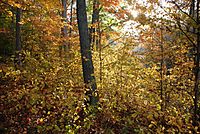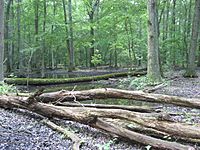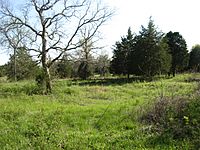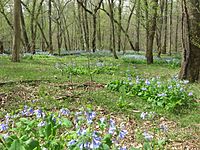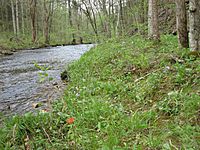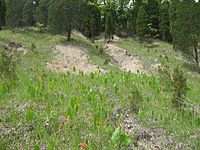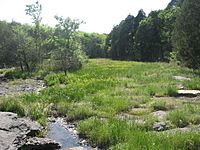Interior Low Plateaus facts for kids
Quick facts for kids Interior Low Plateaus |
|
|---|---|
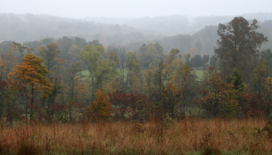
Hoosier National Forest
|
|
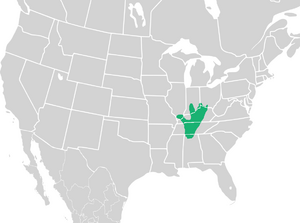 |
|
| Ecology | |
| Biome | Temperate broadleaf and mixed forests |
| Borders |
List
|
| Bird species | 203 |
| Mammal species | 69 |
| Geography | |
| Area | 296,000 km2 (114,000 sq mi) |
| Country | United States |
| States | |
| Conservation | |
| Habitat loss | 46.522% |
| Protected | 7.01% |
The Interior Low Plateaus is a large natural area in the eastern United States. It stretches from northern Alabama through central Tennessee and Kentucky, reaching into southern Illinois, Indiana, and Ohio. This region has many different landscapes, including forests, woodlands, and open grassy areas called prairies.
Contents
About the Interior Low Plateaus
This region is known for its rolling hills and flat areas that have been shaped by nature over time. The southern part has a Humid subtropical climate, meaning it has hot, humid summers and mild winters. The northern part has a Hot-summer Humid continental climate, with warm to hot summers and cold winters.
A special feature of this area is its many karst formations. These are landscapes made of limestone that have been dissolved by water, creating caves and sinkholes. Mammoth Cave National Park in Kentucky is a famous example, with one of the longest cave systems in the world!
The Interior Low Plateaus are part of what the U.S. Forest Service calls the "Central Hardwood Forest." This area covers nearly 65% of Kentucky. It stretches from the western Appalachian Plateau to the Tennessee River. Key parts of this region include the Bluegrass region, the Knobs region, the Highland Rim, and the Shawnee Hills.
How the Land Was Formed
The ground beneath the Interior Low Plateaus is made of sedimentary rocks. These include limestone, sandstone, and shale. These rocks formed from layers of sediment that built up over millions of years. Some rocks, like those in the Nashville Basin and Bluegrass region, are from the Ordovician Period (about 485 to 443 million years ago). Others, like in the Shawnee Hills, are from the Carboniferous Period (about 359 to 299 million years ago).
This region is located at the southern edge of where glaciers once covered the land. Unlike areas further north, the bedrock here is usually close to the surface. This means the shape of the land depends on how strong the underlying rock is. Stronger sandstones create hilly areas, while softer limestones have worn down into gently rolling plains. The hilly parts of the Interior Low Plateaus are not true mountains. Instead, they are "dissected plateaus," which means they are flat areas that have been cut into by rivers and streams, forming valleys and hills.
Natural Areas and Plants
The Interior Low Plateaus are a mix of forests, woodlands, and prairies. In the past, there were many open prairies and savannas (grassy areas with scattered trees). However, most of these have been lost due to farming and stopping natural fires. Today, oak-hickory woodlands are still common. Also, moist forests grow along rivers and streams.
Woodlands
Oak-hickory woodlands are the most common type of natural area here. They are found in many hilly places, like the Western Highland Rim and Shawnee Hills. These woodlands are like a middle ground between a dense forest and an open savanna.
Common trees in these woodlands include post oak (Quercus stellata), white oak (Quercus alba), southern red oak (Quercus falcata), black oak (Quercus velutina), and pignut hickory (Carya glabra). In areas with more limestone, you might find Shumard oak (Quercus shumardii), Chinquapin oak (Quercus muhlenbergii), and Carolina shagbark (Carya carolinae-septentrionalis).
In drier, more acidic woodlands, there are chestnut oak (Quercus montana) and Virginia pine (Pinus virginiana). In wet, flat areas, you'll see willow oak (Quercus phellos), overcup oak (Quercus lyrata), pin oak (Quercus palustris), sweetgum (Liquidambar styraciflua), and blackgum (Nyssa sylvatica). These woodlands also have many sun-loving wildflowers like goldenrod (Solidago), sunflower (Helianthus), and aster (Symphyotrichum).
=Prairie and Savanna
In the past, the flat parts of the Interior Low Plateaus had huge open prairies. These areas were common in the Mitchell Plain and Pennyroyal Plateau. Early settlers described them as mostly treeless, with Greater prairie chickens and herds of Bison. Today, some prairies still exist where people manage them with controlled fires or by removing trees.
Dry prairies are the most common type left. They are often found on land not good for farming. They are mostly covered by little bluestem (Schizachyrium scoparium) and three-awn grass (Aristida purpurascens). Mesic prairies, which are moister, are rarer. They have very tall grasses like Indian grass (Sorghastrum nutans), big bluestem (Andropogon gerardi), and plume grass (Erianthus alopecuroides). Wet prairies are the rarest. They have plants like gamagrass (Tripsacum dactyloides), prairie cordgrass (Spartina pectinata), and many rushes (Juncus) and sedges (Carex).
Important prairie areas are found at Fort Campbell and Arnold Air Force Base. Blackjack oak (Quercus marilandica) was one of the few trees that could survive the yearly wildfires in the prairies.
Forests
Thick forests with a closed canopy are also naturally found here. They grow in places like along rivers, in river bottoms, and in areas with many hills and valleys.
Moist (mesic) forests often grow in narrow stream gorges. These forests are full of different spring wildflowers. They are mostly made up of sugar maple (Acer saccharum), beech (Fagus grandifolia), basswood (Tilia americana), northern red oak (Quercus rubra), and tuliptree (Liriodendron tulipifera).
In the Eastern Highland Rim, these forests start to look more like those in the Appalachian Mountains. They include trees like eastern hemlock (Tsuga canadensis), yellow buckeye (Aesculus flava), and cucumber magnolia (Magnolia tripetala). Forests in acidic sandstone areas of the Shawnee Hills also have Appalachian species like yellow birch (Betula alleghaniensis) and umbrella magnolia (Magnolia tripetala).
Forests that grow in floodplains (areas near rivers that flood) are still fairly common. However, many have been cleared for farming. These forests are dominated by sugarberry (Celtis laevigata), boxelder (Acer negundo), silver maple (Acer saccharinum), and sycamore (Platanus occidentalis).
In the Bluegrass region of Kentucky, forests used to be very common. They had sugar maple (Acer saccharum), bitternut hickory (Carya cordiformis), Ohio buckeye (Aesculus glabra), blue ash (Fraxinus quadrangulata), and chinquapin oak (Quercus muhlenbergii). Sadly, most of these forests were cut down by early settlers. Today, trees like hackberry (Celtis occidentalis), black cherry (Prunus serotina), black walnut (Juglans nigra), and white ash (Fraxinus americana) are more common.
Barrens and Glades
Barrens are open, treeless areas found on slopes, often with thin soil. They are scattered throughout the Outer Bluegrass, Inner Nashville Basin, Shawnee Hills, and parts of the Highland Rim. It's not fully clear if these areas stay open because of fires or just because of the soil. They usually have short grasses like little bluestem (Schizachyrium scoparium) and large, showy wildflowers like prairie dock (Silphium terebinthinaceum) and blazing star (Liatris). Many well-preserved barrens are found in Adams County, Ohio.
Glades are flat areas where bedrock is exposed. In the Nashville Basin, glades were often found within a mix of barren and woodland areas. Many are now surrounded by dense groups of redcedar (Juniperus virginiana) and redbud (Cercis canadensis). Glades are most common in the Nashville Basin, but rare examples exist in other areas. Plants in glades are adapted to very dry summers and standing water in spring. The glades in the Nashville Basin are special because they have many unique plant species found nowhere else. These include Nashville glade cress (Leavenworthia stylosa) and Tennessee milk-vetch (Astragalus tennesseensis). Glades are well-preserved because they are not good for farming. Many examples can be seen in Cedars of Lebanon State Park.
Wetlands
The Interior Low Plateau has many sinkhole ponds in its karst regions. These isolated ponds were once surrounded by wet prairies. Today, they are often covered by swamp forests with trees like swamp cottonwood (Populus heterophylla) and red maple (Acer rubrum). Many of these wetlands have been destroyed to make way for farming.
Emergent shrub sloughs are found along major rivers like the Cumberland River and Tennessee River. These areas are dominated by buttonbush (Cephalanthus occidentalis). Along the Tennessee River, you can also find bald-cypress (Taxodium distichum). Most of these sloughs have been lost due to dam construction and farming.
A rare type of wetland here is the calcareous seepage fen. These are found in the Highland Rim and have plants like grass of Parnassus (Parnassia grandifolia) and the endangered Tennessee yellow-eyed grass (Xyris tennesseensis). Calcareous seeps are also found near glades in the Inner Nashville Basin. These areas often have many sunnybells (Schoenolirion croceum) and other rare plants.
Animals of the Region
This region has the most diverse freshwater animals in North America! The Duck River in Tennessee is one of the top three most biologically rich rivers in the world. It is home to over 150 types of fish, 60 types of freshwater mussels, and 22 types of aquatic snails. The Green River also has a similar amazing variety of life. This high number of freshwater mussels is due to the limestone bedrock. The limestone makes the water less acidic, which helps mussels build their shells.
In the woodlands, you can find birds like vireos and tanagers. Mammals include Eastern gray squirrels, chipmunks, raccoons, and opossums.
Challenges to Nature
In the past, frequent fires helped keep the oak trees dominant in this region's savannas. However, since the 1930s, policies to stop fires have changed the forests.
Today, very little of the original natural habitat remains. For example, 70–95% of the bottomland hardwood forests are gone, and only a tiny fraction (0.02%) of the original oak savannas are left. Even though much of the area is still forested, these forests are often broken up into small pieces. They have also been changed by human activities like building, farming, and stopping fires.
The forests are mostly made of oak and hickory trees. But because fires are stopped, other trees like maples and yellow poplar are growing in the understory (the layer of plants below the main tree canopy). This makes it hard for new oak trees to grow. In some places, habitats are also threatened by cities growing and by invasive species. These are plants that are not native to the area and can take over, like non-native privet, honeysuckle, garlic mustard, and kudzu.
Protected Areas
Some important natural areas in the Interior Low Plateaus are protected. These include:
- Mammoth Cave National Park
- The Land Between the Lakes National Recreation Area in Tennessee and Kentucky
- Hoosier National Forest and Yellowwood State Forest in southern Indiana
- The Edge of Appalachia Preserve in Ohio
- The Shawnee Hills in southern Illinois
Images for kids
See also
 In Spanish: Mesetas bajas del interior para niños
In Spanish: Mesetas bajas del interior para niños


